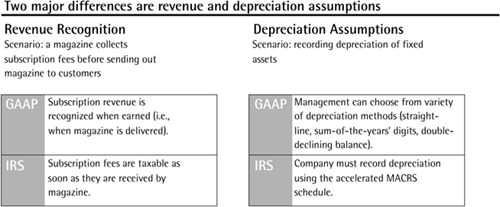Deferred Taxes
Recall from our earlier discussion of deferred taxes that for the purposes of reporting financial statements to the public (via the SEC), companies prepare their financial statements in accordance with U.S. GAAP, while also preparing financial statements to the IRS for filing tax returns.
The differences between GAAP tax expense and IRS taxes payable are recorded as deferred tax assets and liabilities, and stem, for example, from differences between revenue and depreciation assumptions under GAAP and the IRS (Exhibit 6.15).
We have learned that deferred tax assets are created by tax code when taxes payable to the IRS are anticipated to be lower than the tax liability anticipated on the GAAP financial statements.
A deferred tax liability is created and reported on the balance sheet when an asset or liability is valued differently under GAAP financial statements than it is on the company’s tax returns, and that difference results in a greater tax expense on the financial statements than accrual cash taxes payable on the tax return.
By far the most common way that deferred tax liabilities are created is because companies use an accelerated depreciation method (MACRS) in their tax returns versus the straight-line method for financial reporting on the income statement. This treatment of depreciation ...
Get Crash Course in Accounting and Financial Statement Analysis, Second Edition now with the O’Reilly learning platform.
O’Reilly members experience books, live events, courses curated by job role, and more from O’Reilly and nearly 200 top publishers.


